|
Caddy Staging Area...
Joel Purpur, Park Ridge Country Club, Park Ridge, IL:
 "The brick paver patio near the practice green is finished. The patio will serve as the staging area for caddies as they wait to go out with players during the day. Before hand, this area of turf had constant foot traffic from caddy staging, and from players alike using the practice green. Combined with a large amount of shade from the maple trees, it was very difficult to grow a healthy stand of turf in the area. The patio is a great alternative and blends in nicely with the existing pavers near the proshop."
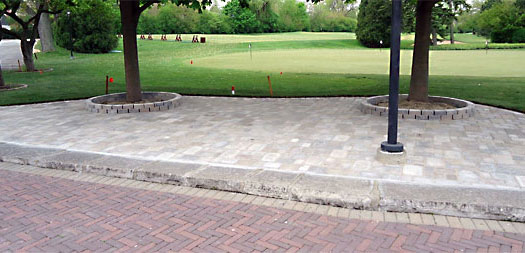
Visit Joel's blog at parkridgeccgrounds.blogspot.com.
|
 |
|
Riparian areas...
Brian Boyer, Cinnabar Hills Golf Club, San Jose, CA:
 "Aside from the golf course, the Maintenance department also manages the riparian areas throughout the golf course. We have 10.17 acres that were constructed per the mitigation agreement. Per the agreement, there are many standards that we must achieve in order to stay in compliance. The biggest one is that we must maintain 80% survival in years 1-3 and 60% survival in years 3-10. If we were to fall below that standard, we go back to year 1. I am proud to say that the staff and myself have never had a failing year. The other items that are monitored are percent cover, basal area, tree height, and overall site maintenance. The quarterly monitoring is done by Live Oak Associates.
The species of plants and trees that you will find in our riparian areas include Valley Oak, Coast Live Oak, California Bay, California Sycamore, Red Willow, California Buckeye, Mexican Elderberry, California Wild Rose, Mugwort, Pacific Blackberry, Common Snowberry, Coyote Bush and California Sage.
"The native grasses must be kept low to give the raptors the opportunity to catch the gophers and other critters..." |
Each riparian area needs to be weed free and the native grasses must be kept low. The reason for this is to give the raptors the opportunity to catch the gophers and other critters that may impede the development of the riparian areas. Each area also has drip irrigation to every plant to ensure proper establishment and the irrigation must be maintained regularly. As the riparian areas become more established the irrigation is slowly reduced until seasonal rains will suffice. The ultimate goal is to leave behind a naturally reproducing riparian area."
Visit Brian's blog at cinnabarhills.blogspot.com
 "A riparian zone or riparian area is the interface between land and a river or stream. Riparian zones are significant in ecology, environmental management, and civil engineering because of their role in soil conservation, their habitat biodiversity, and the influence they have on fauna and aquatic ecosystems, including grassland, woodland, wetland or even non-vegetative. The word "riparian" is derived from Latin ripa, meaning river bank."
|
 |
|
Practice Tee Drainage Project...
Chris Tritabaugh, Northland Country Club, Duluth, MN:
 "This morning the staff will finish up the last portion of the drainage project on the practice tee and range. The project encompassed two separate areas. The first was aimed at capturing drainage water coming from near the 150 yard target green. The second project will dry up the left side of the practice tee; a chronically wet area.
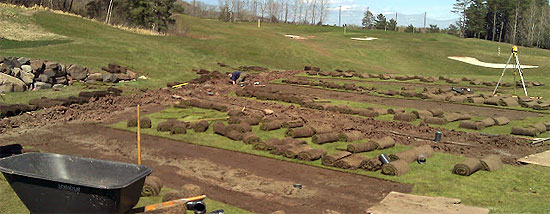
With red clay our best bet is to remove all sod in which the work will take place.
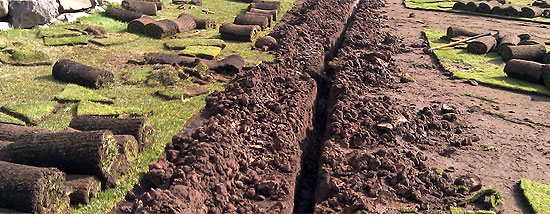
Rather than try and clean the clay spoils off the turf we strip the sod so we are able to scrap them up with the bobcat. If you have ever shoveled red clay then you know what I am talking about. |
"As with any drainage project out here we shoot for the stars and hope to make it across the golf course..." |
As with any drainage project out here we shoot for the stars and hope to make it across the golf course. By this I mean drainage work in red clay is a mess. When the project started we had hoped to spend a week hitting a number of problem areas around the course. In the end the practice area work alone took the entire week. A bit frustrating but not entirely unexpected.
The sod will need some rolling and aeration but will eventually be a large improvement."
Visit Chris's blog at northlandgrounds.blogspot.com.
|
 |
|
Trials on the putting green...
Pat O'Brien, Hyde Park Golf and Country Club, Cincinnati, OH:
 "On the practice putting green a series of trials are being conducted using a plant growth regulator (Trimmit) and various fertilizer strategies to enhance the creeping bentgrass and regulate the Annual Bluegrass. A
nnual bluegrass is not the ideal grass for this region because it is susceptible to many plant pathogens, displays poor playability in the spring because of seedhead production and it is not heat tolerant. The Annual Bluegrass in these plots will exhibit stress when the weather heats up.

Our goal is to develop a long term strategy to reduce the populations of annual bluegrass and enhance the playability and sustainability of the putting surfaces. We will continue with updates throughout the summer with our trials."
Visit Pat's blog at hydeparkgolfandcountryclub.blogspot.com.
|
 |
|
Fescue management...
Michael Stachowicz, Dedham Country and Polo Club, Dedham, MA:
 "Dedham has many areas that are too rough to mow, the slopes are too severe to mow, too wet to mow regularly, or would look ratty and eventually dusty if we tried to maintain them as rough. This is why we let certain areas of the course naturalize.
Tan waves of fescue seedhead swaying in the wind. It is an image that harkens back to the origins of the game. It adds contrast and definition to the irrigated turf of the actual golf hole. It is good for the environment in many ways including adding a habitat that doesn't exist in the abundance it once did when farms dotted the New England landscape, it requires little water, fewer fossil fuels from less mowing, and no fertilizer. And yet it is not low maintenance.
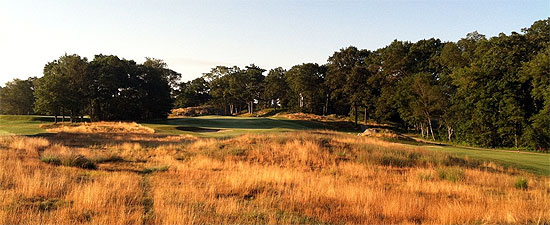
Just just let an area grow up to seed by not mowing it will not, in most cases, provide the surface that we are looking for as far as playability and aesthetics. It is a weed free stand of fescue that we are looking for, yet if we maintain this correctly we have a thin stand of fescue with a lot of gaps and bare soil... in other words a nice invitation to weeds. In addition, unless the area is on gravel or sand where the fescue has a competitive advantage, we are fighting wet soils with eons full of weed seed. In New England, these areas left to their devices would evolve into thorny plants, brush, and sumac and then into a forest. These areas take a good deal of managing.
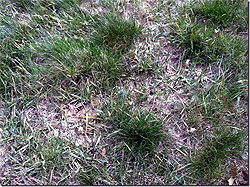 This is a picture of clumps of fescue with the quackgrass that has been treated with Sethoxydim. This will provide a great playing surface; if not treated it would be thick and unplayable. |
Management is much tougher in these areas than regular turf areas because we only have a short window before the area goes to seed and we can no longer bring equipment through it without leaving any tires tracks. April and the first part of May are our only chances to influence what this stand of turf looks like.
The first part of what we do is mow it, and we mow it low with a flail mower that cuts grooves into the surface... it thins. We just did our last mowing this week... we time this to hopefully catch the plant as it is taking energy away from growing grass blades and putting it toward the seedheads. This also promotes thinness because when we remove this leaf material the plant will not generate that much more during this season unless it rains a good deal.
The second part is the complicated mixing of treatments for removing unwanted turf types and weed types, and applying a pre emergent to prevent weeds that we think may come up during the year. To top it off we apply a treatment to minimize ticks.
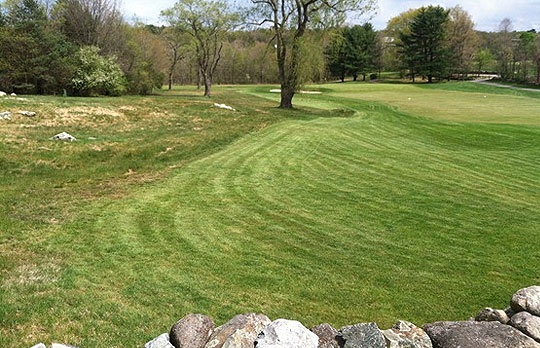 On the left side the fescue has been treated with Echelon and Sethoxydim. Echelon is new for us this year and will help improve our pre emergent success as it treats for nutsedge pre and post as well as other weeds. We will follow up in two weeks with a different pre emergent (Dimension) mixed with a new herbicide called Tenacity. Tenacity is a very wide ranging herbicide and powerful, but applied a super low rates. |
If it stays dry this year, or even if it is normal this year, these fescue areas will be beautiful and playable in most spots. It has taken years of research, classes, networking, and then treating to get these areas to the point where they are almost 100% fescue and not just hay."
Visit Michael's blog at mstachowicz.wordpress.com
|
 |
|
Herbicides: Spring vs. Fall
Steve Cook, CGCS MG, Oakland Hills Country Club, Bloomfield Hills, MI:
  "Most of us want to kill weeds like dandelions when they are most visible: in the spring. Spring flowering weeds are visible because ... they are flowering. That tells us that the plant is in a reproductive cycle, using available energy to produce flowers and seeds for new plants.
Most of the flow of water and food within the plant goes upward to sustain the production of these flowers. So it follows then, that a larger percentage of the herbicide we apply in the spring also goes upward and not down to the root. That's why the flower head wilts long before any leaves show signs of damage.
"It is much more efficient to apply broadleaf herbicides in the fall, when the plant is translocating water and nutrients (along with the herbicide) down..." |
It is much more efficient to apply broadleaf herbicides in the fall, when the plant is translocating water and nutrients (along with the herbicide) down to the root system in order to get ready for a long dormant season. This is particularly relevant for perennial weeds like dandelions.
While we do make some herbicide applications in the spring, it is mostly cosmetic. Our most efficient use of resources is to make these applications in October, when we get a much better "kill ratio" on perennial weeds by attacking the root systems."
Visit Steve's blog at ohccturf.blogspot.com.
|
 |
Yessirree, another good looking blog! Steve Wilson, CGCS, of Meadowbrook Golf and Country Club in Prairie Village, KS, has a new blog theme with custom header courtesy of TurfNet. We would be happy to do that for other TurfNet member/bloggers as well. All we need are a few good course photos (at least 1000px wide), a club logo and a few head/shoulder shots to work with.

|
 |
|
About our Blog Aggregator: Many superintendents are now hosting private blogs to better communicate with their golfers and/or members. Beyond local weather and course conditions, there is a great deal of information about projects, methodologies and techniques that would be of value to other superintendents — hence our Turf Blog Aggregator. As every blogger struggles occasionally with content, we also include posts intended to educate golfers about turf maintenance for others to use as a template for their own blogs.
Miss any previous issues of TBA? You can find them all here.
Turf Blog Aggregator(TM) is a trademark of Turnstile Media Group.
|
|